Overview
Recruiting abbreviations are indispensable tools for HR professionals, streamlining communication and enhancing the efficiency of hiring processes. Consider this: how often do misunderstandings arise from varied familiarity with these terms among team members? While abbreviations like ‘JD’ (Job Description) and ‘ATS’ (Applicant Tracking System) facilitate clearer discussions and improve candidate quality, their careful usage is paramount. This balance ensures that all team members are aligned, ultimately leading to a more effective recruitment strategy.
Key Highlights:
- Recruiting abbreviations, like ‘JD’ (Job Description) and ‘ATS’ (Applicant Tracking System), streamline communication in hiring processes.
- 62% of talent teams using an ATS report sourcing higher-quality candidates compared to those relying solely on inbound applications.
- 94% of employers believe skills-based hiring better predicts job performance, highlighting the need for clear communication.
- Misunderstandings can arise from abbreviations due to varying familiarity among team members, potentially complicating hiring discussions.
- Best practices for using abbreviations include defining terms upon first use and sticking to commonly accepted acronyms.
- Staying updated on evolving recruiting terminology is critical for effective communication and adapting to industry changes.
- Effective communication directly influences hiring success, with organizations prioritizing clarity seeing higher offer acceptance rates.
Introduction
In the fast-paced world of recruitment, where clarity and efficiency are paramount, understanding the language of abbreviations can make all the difference. These shorthand terms—such as ‘JD’ for Job Description and ‘ATS’ for Applicant Tracking System—serve as vital tools that streamline communication among HR professionals, candidates, and hiring managers alike.
As the recruitment landscape evolves with new technologies and methodologies, the significance of these abbreviations becomes increasingly clear. They not only facilitate quicker decision-making but also enhance the quality of hires by fostering better collaboration and understanding within teams.
However, the use of abbreviations is not without its challenges. Miscommunications can arise when team members are unfamiliar with specific terms. This raises an important question: How can we ensure that everyone is on the same page?
This article delves into the importance of recruiting abbreviations, their common usage, best practices for effective communication, and the evolving nature of this essential vocabulary in the hiring process.
Understanding Recruiting Abbreviations: Importance and Relevance
Recruiting abbreviations are essential terms in the hiring process, designed to streamline communication and enhance efficiency. In the fast-paced field of hiring, where prompt decision-making is crucial, these acronyms enable HR experts to convey intricate ideas concisely. Terms such as ‘JD’ for Job Description and ‘ATS’ for Applicant Tracking System serve as recruiting abbreviations that facilitate clearer discussions regarding job roles and recruitment technologies.
The significance of these abbreviations extends beyond mere convenience; they play a vital role in enhancing interaction among HR teams, candidates, and hiring managers. For example, a recent case study revealed that 62% of talent teams utilizing an ATS reported sourcing higher-quality candidates compared to those relying solely on inbound applications. This statistic underscores how efficient dialogue, supported by shorthand, can significantly influence the quality of hires.
As the hiring landscape evolves, the adoption of skills-based hiring is becoming increasingly prevalent. A notable 94% of employers believe this approach better predicts job performance, with 81% of companies already implementing it. This shift highlights the necessity for clear and effective communication, where abbreviated forms can assist in expressing specific skills and qualifications swiftly.
Furthermore, anticipated trends for 2025 suggest challenges such as hiring team turnover and heightened competition for talent, further emphasizing the need for effective communication strategies in hiring.
Expert opinions further reinforce the relevance of recruiting abbreviations in hiring processes. Erik van Vulpen, Founder and Dean of AIHR, states, “Hiring ROI (Return on Investment) helps measure the overall effectiveness and financial return of your hiring strategies.” This perspective highlights the importance of clarity and efficiency in hiring, enabling HR professionals to focus on strategic decision-making rather than becoming overwhelmed by lengthy explanations.
As sectors continue to advance, particularly in technology, healthcare, and renewable energy, the demand for talented individuals will surge, making effective interaction more essential than ever.
In summary, understanding and applying recruiting abbreviations is crucial for HR professionals aiming to navigate the complexities of the hiring landscape effectively. By promoting clearer dialogue and enhancing hiring effectiveness, these terms play a significant role in achieving successful hiring outcomes.
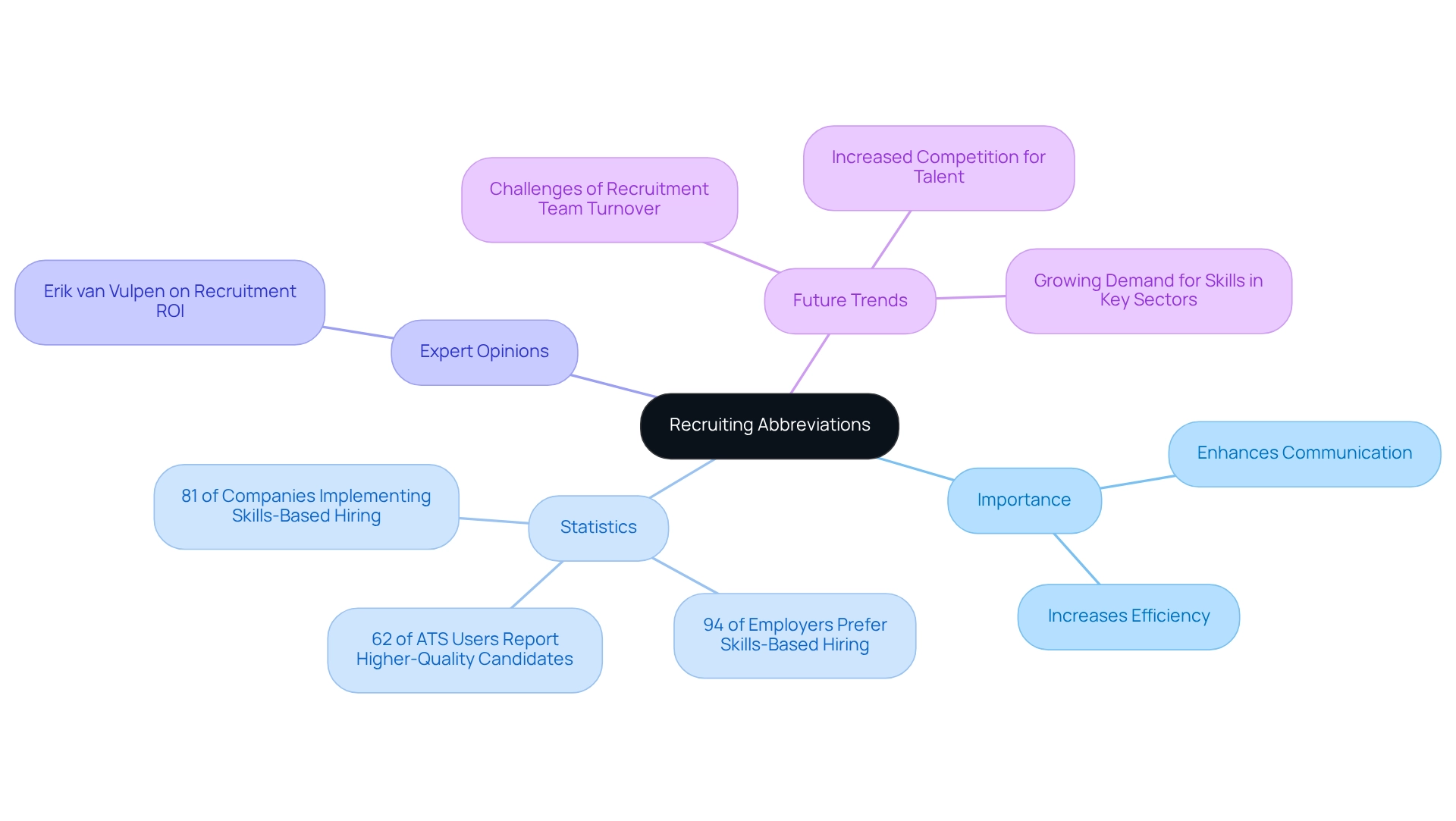
Common Recruiting Abbreviations: A-Z Overview
In the realm of hiring, understanding recruiting abbreviations is essential for effective communication among HR professionals. Here’s a list of frequently used recruiting abbreviations:
- ATS: Applicant Tracking System
- JD: Job Description
- FTE: Full-Time Equivalent
- RPO: Recruitment Process Outsourcing
- TA: Talent Acquisition
- HM: Hiring Manager
- RC: Recruiting Coordinator
- KPI: Key Performance Indicator
These abbreviations are pivotal in streamlining the recruitment process, empowering HR teams to convey information succinctly and effectively. For instance, the use of ATS has gained prominence, with contemporary systems designed to analyze resumes for relevant information, although the ultimate hiring decision rests with human recruiters.
This underscores the importance of grasping both the technological and human elements involved in hiring. Notably, a case study indicates that the statistic claiming ATS dismisses up to 75% of resumes oversimplifies the role of ATS, highlighting the necessity for precise job descriptions (JDs) that accurately reflect the roles and expectations.
Moreover, statistics show that 52% of candidates prioritize competitive compensation packages, emphasizing the need for clear communication in job postings. Eric Eddy from CPA Resources Global Professionals underscores the firm’s ability to deliver exceptional candidates swiftly and effectively, reinforcing the significance of efficient communication in hiring. Familiarity with these terms not only enhances communication but also contributes to a more positive candidate experience, which is vital in today’s competitive job market.
As hiring practices evolve, staying informed about the latest recruiting abbreviations and their definitions will enable HR professionals to navigate the employment landscape more adeptly. Recent hiring data also reveals trends that highlight the growing reliance on social media and the importance of clear messaging, further aligning with the topic of abbreviations in hiring.
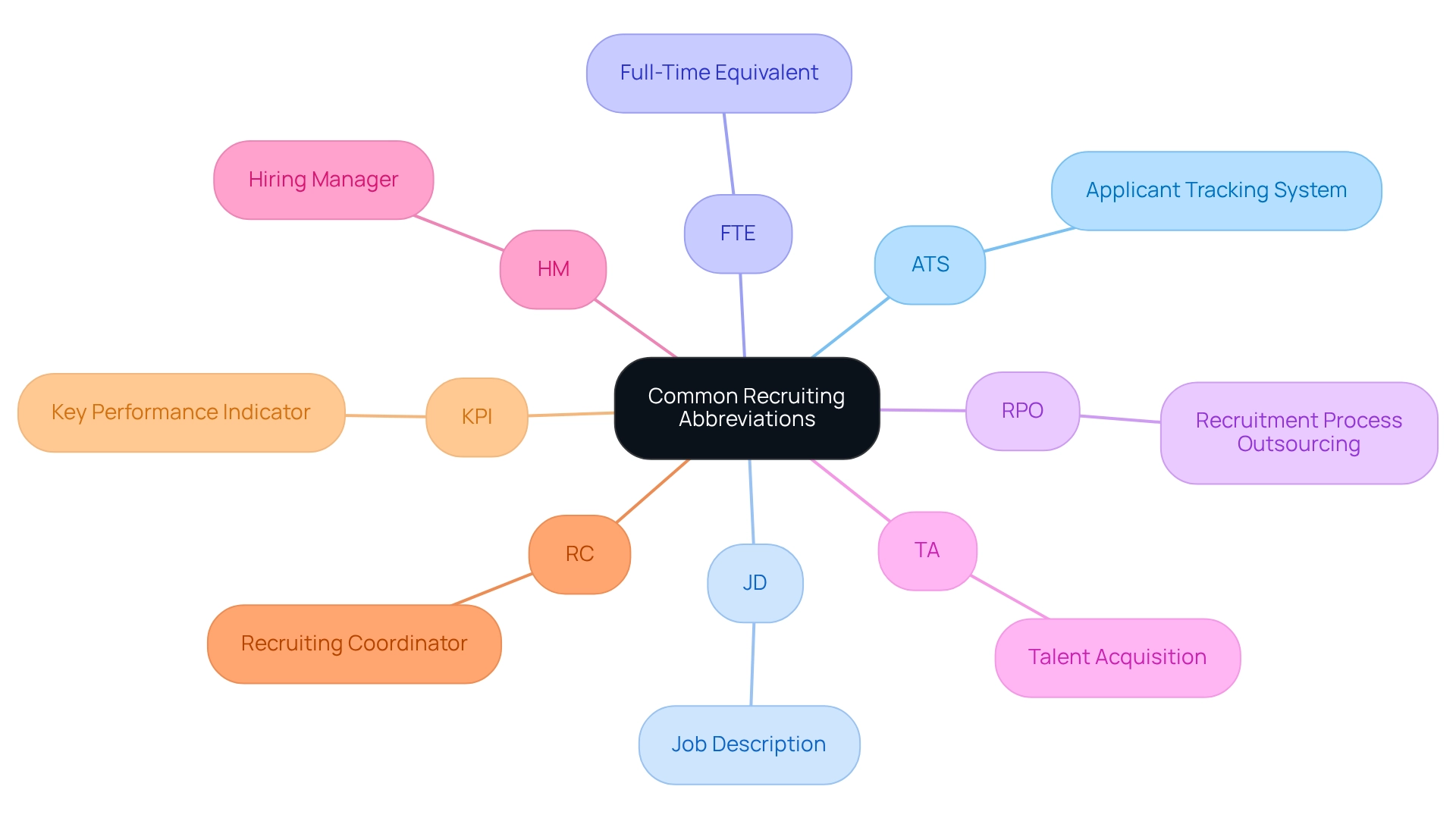
The Role of Abbreviations in Streamlining Recruitment Processes
The strategic use of recruiting abbreviations is essential in enhancing hiring procedures, significantly decreasing the time invested in interaction. For instance, employing ‘JD’ as a recruiting abbreviation instead of ‘Job Description’ not only streamlines written and verbal exchanges but also accelerates decision-making—an imperative in high-volume recruitment scenarios. Boutique Recruiting specializes in personalized searches tailored to the specific requirements of businesses across various sectors, including roles such as Chief Technology Officer, HR Director, and other technical and HR positions, ensuring that interaction remains both efficient and effective.
Organizations that adopt recruiting abbreviations report a substantial enhancement in information exchange, allowing teams to focus on more strategic facets of hiring. Notably, small enterprises are accelerating their hiring methods, with text recruiting showing an eightfold greater response rate than email, further underscoring the effectiveness of communication in hiring. The standardization of language through common recruiting abbreviations fosters improved collaboration among hiring teams.
This mutual comprehension ensures that all participants are aligned on job requirements and candidate qualifications, ultimately boosting the effectiveness of hiring efforts. Furthermore, widely utilized hiring technologies—such as virtual interviews (62%), digital document submission (60%), and virtual training or onboarding (56%)—often integrate recruiting abbreviations to facilitate faster interactions and data processing, which is crucial for attracting top candidates in today’s competitive talent landscape.
When evaluating recruiter performance, metrics like email open rates and interview conversion rates can reveal how efficiently recruiting abbreviations are applied in exchanges. The case study titled ‘Evaluating Recruiter Performance’ illustrates that by analyzing these metrics, organizations can pinpoint areas for improvement and enhance their hiring strategies. As Eric Eddy noted, Boutique Recruiting’s capacity to deliver top-notch candidates swiftly and efficiently highlights the significance of streamlined communication.
Overall, the strategic application of recruiting abbreviations not only streamlines processes but also contributes to a more cohesive and efficient hiring environment, particularly in navigating the talent war. For additional details on how Boutique Recruiting can assist with your tailored hiring solutions, please reach out to us.
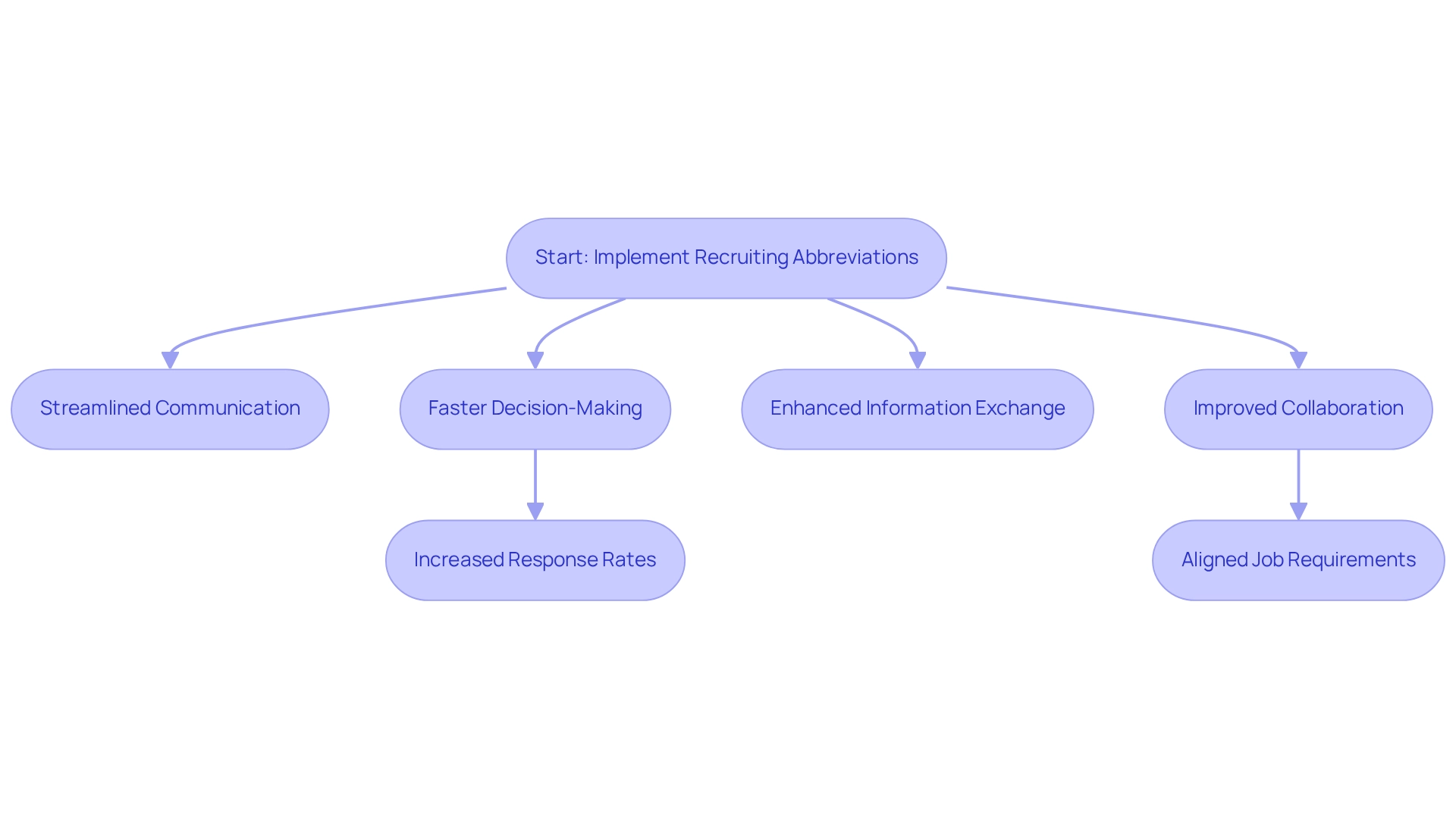
Challenges of Using Recruiting Abbreviations: Misunderstandings and Miscommunications
While recruiting abbreviations can enhance interactions, they also carry significant risks of misunderstandings and misinterpretations during hiring procedures. A survey conducted in February 2024 revealed that 1,020 Americans showcased varying levels of familiarity with workplace interaction tools, underscoring that not all team members may be adept at specific shorthand. This gap in knowledge can lead to misunderstandings and inefficiencies in hiring discussions.
Moreover, many acronyms possess multiple interpretations depending on the context, further complicating interactions. For example, ‘RPO’ can refer to both Recruitment Process Outsourcing and a specific role within a company, creating ambiguity in conversations. Such misunderstandings can yield tangible consequences; companies with strong internal communication practices experience better retention rates and higher shareholder returns. A case study on employee engagement found that engaged employees can elevate a company’s operating income by 19.3% annually.
As Eric Eddy noted, Boutique Recruiting’s ability to deliver exceptional candidates swiftly and effectively underscores the importance of transparent communication in hiring, particularly in a competitive landscape where top candidates are discerning and evaluate prospective employers with equal rigor.
To address these challenges, HR professionals should prioritize educating all staff on the recruiting abbreviations commonly used. Insights from the State of the Sector 2024 report reveal that while engagement surveys are a prevalent method for collecting employee feedback, only 44% of employees feel they have a straightforward avenue to share their thoughts. Promoting clarity by spelling out terms upon first use can significantly diminish the occurrence of miscommunication incidents.
By fostering a culture of open dialogue and empathy, organizations can refine their hiring processes and ensure that all team members are aligned in their efforts to attract and retain top talent, particularly in specialized legal roles such as General Counsel, Attorney, and Paralegal, where Boutique Recruiting excels. For tailored hiring solutions, HR managers are encouraged to reach out to Boutique Recruiting.
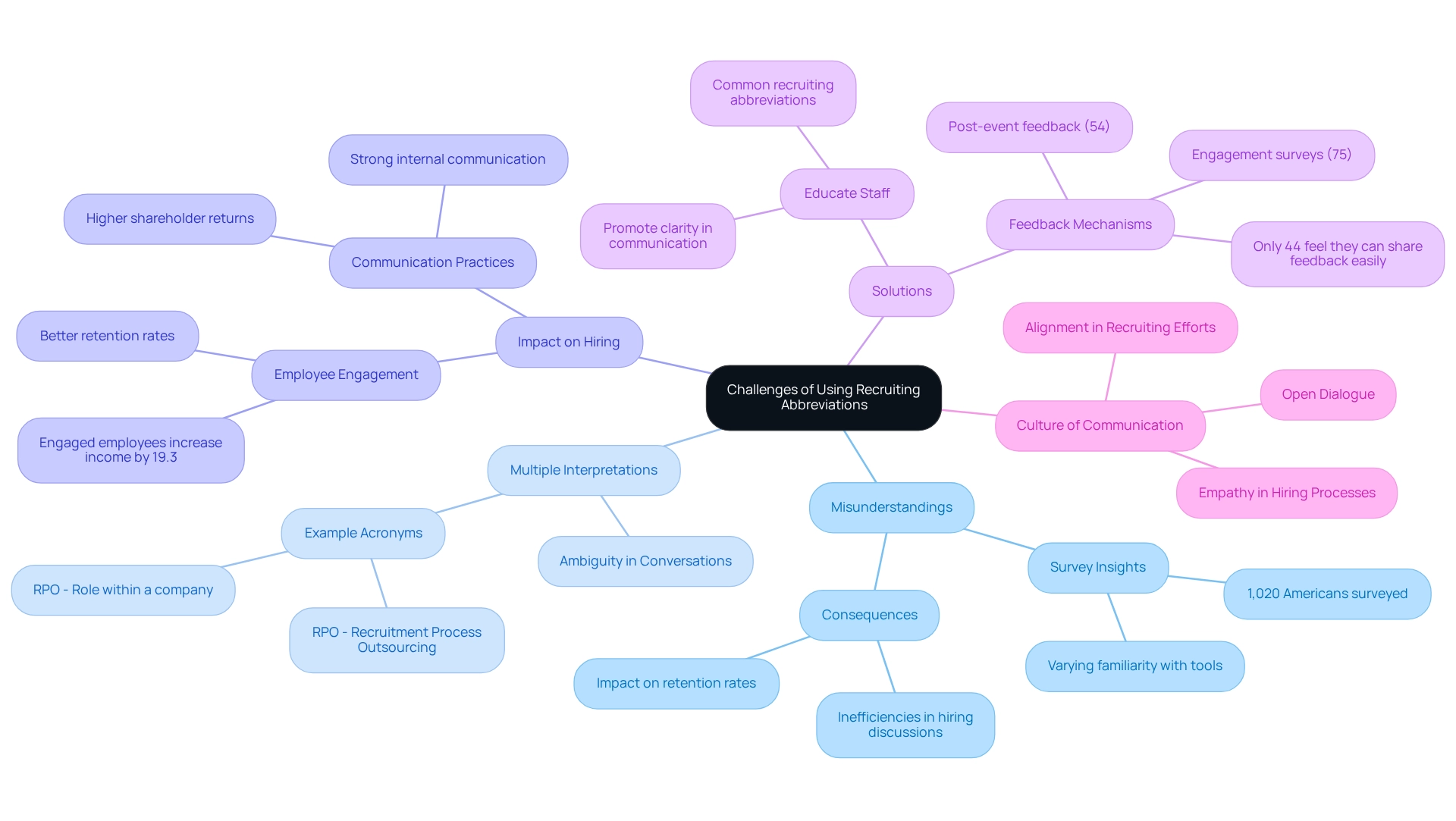
Staying Current: The Evolving Landscape of Recruiting Abbreviations
The landscape of recruiting abbreviations is continuously evolving, influenced by advancements in technology, shifts in industry practices, and changing workforce dynamics. As hiring strategies adapt to modern challenges—such as the rise of remote work and the increasing reliance on digital hiring processes—new recruiting abbreviations are being developed to encapsulate these developments. For instance, ‘DEI’ (Diversity, Equity, and Inclusion) has emerged as a focal point in recent years, underscoring the industry’s commitment to fostering inclusive workplaces.
In 2025, the relevance of such terms is more pronounced than ever, with 40% of organizations prioritizing mental health initiatives, including Employee Assistance Programs (EAPs), to enhance employee well-being and retention. These programs are crucial as they help employees navigate challenges, ultimately improving long-term retention. Are you aware of how these initiatives can transform workplace culture?
HR professionals must remain vigilant and informed about these changes to ensure they utilize the most relevant and effective terminology in their communications. Engaging with industry publications, attending workshops, and participating in professional networks are essential strategies for keeping knowledge current. Furthermore, the emergence of recruiting abbreviations such as ‘ATS’ (Applicant Tracking System) and ‘SaaS’ (Software as a Service) reflects the increasing integration of technology in hiring processes.
Boutique Recruiting specializes in custom searches tailored to the unique needs of companies across various industries, including roles such as Chief Technology Officer, Engineer, Solution Architect, Systems Administrator, and HR positions. Their expertise has successfully assisted hundreds of SaaS companies in their growth, illustrating the importance of understanding these evolving terms. Why settle for generic solutions when you can have tailored recruitment that aligns with your specific needs?
As Anh Nguyen, a content creator and HR software reviewer, notes, “With a Business degree in one hand and a lifelong passion for writing in the other, I have dedicated the past five years to carving my path in tech writing.” This highlights the significance of staying updated on new recruiting abbreviations. As the hiring landscape continues to shift, staying informed about new trends in recruiting abbreviations will empower HR professionals to communicate effectively and adapt their strategies to meet the demands of a dynamic job market.
Boutique Recruiting’s commitment to understanding company culture and specific job requirements further aligns with these evolving practices, ensuring they deliver candidates who fit both technically and culturally. For tailored recruitment solutions in the U.S. and Canada, contact Boutique Recruiting to learn more about how we can assist you in navigating the talent landscape.
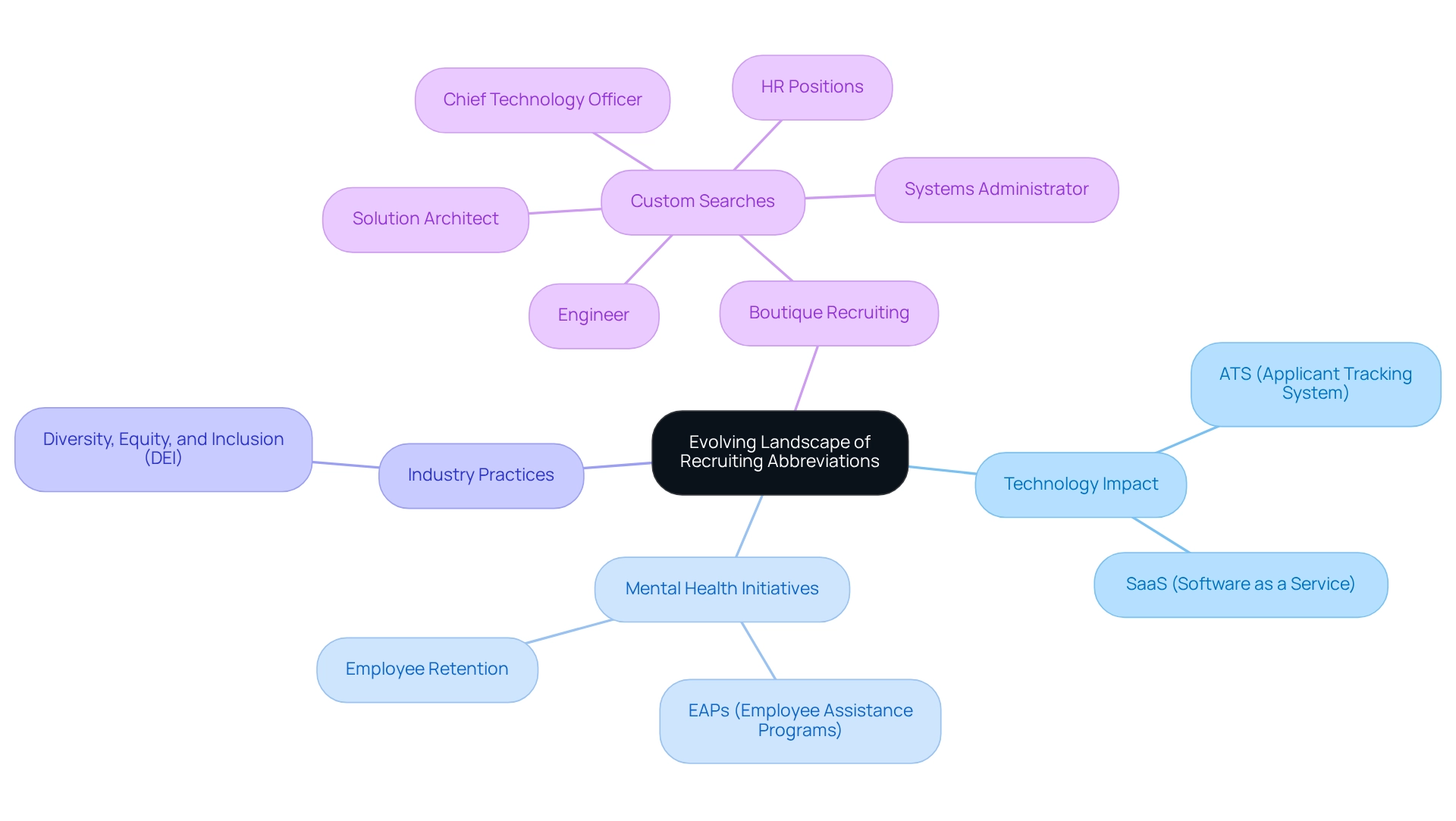
Best Practices for Using Recruiting Abbreviations in HR Communication
To enhance the use of recruiting shorthand in HR communication, it is essential to implement best practices that ensure clarity and understanding.
- Define Short Forms: Always provide a clear definition for each short form upon its first use in any document or discussion. This practice guarantees that all group members comprehend the terminology in use.
- Use Commonly Accepted Terms: Stick to widely recognized short forms to minimize confusion. Familiarity with standard terms is crucial for maintaining clarity across communications.
- Encourage Feedback: Create an open environment where team members feel comfortable seeking clarification on any terms they do not understand. This approach fosters improved interaction and understanding within the team.
- Regularly Update Terminology: Stay informed about new terms and industry trends to keep your messaging relevant and effective. Regular updates can help prevent misunderstandings that arise from outdated terminology. HR acronyms are essential for HR professionals, and new terms are continually being added.
- Limit Usage: Be mindful of the frequency of abbreviations in formal correspondence. Excessive use can undermine professionalism and clarity, making it more challenging for recipients to grasp the intended message.
By adhering to these best practices, HR professionals can significantly enhance their effectiveness in conveying information about recruiting abbreviations, ensuring that all team members are aligned in their understanding. This clarity is especially vital in a competitive job market, where effective expression directly influences hiring success and employee satisfaction. In fact, surveys indicate that 51% of employees experience increased stress due to inadequate interaction, underscoring the need for clarity in HR practices.
Moreover, effective interaction can lead to increased employee engagement; as noted by Officevibe, 69% of employees stated that they would exert more effort if they felt more valued. Furthermore, evaluating the efficiency of internal messaging during emergencies highlights the significance of having clear and effective strategies, particularly in critical situations. Lastly, considering broader contexts like Volunteer Time Off (VTO), which typically ranges from 8 to 40 hours per year, illustrates the importance of interaction in fostering employee engagement.
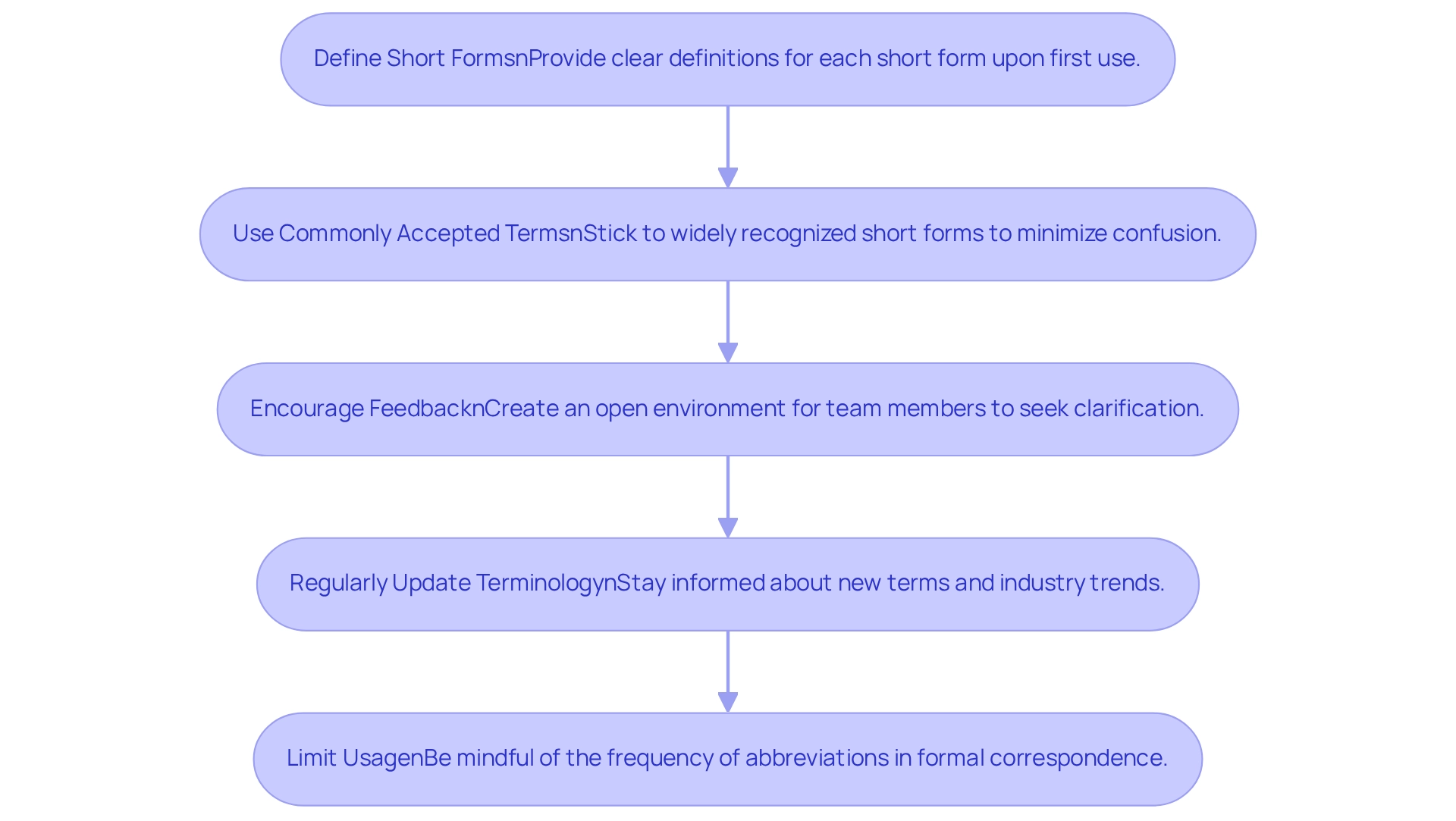
Key Takeaways: Mastering Recruiting Abbreviations for HR Success
Mastering recruiting abbreviations is essential for HR experts aiming to enhance communication and streamline hiring processes. Key takeaways include:
- Abbreviations can significantly improve efficiency in recruitment communications; however, they may also lead to misunderstandings if not used judiciously.
- Knowledge of common acronyms such as ‘JD’ (Job Description), ‘ATS’ (Applicant Tracking System), and ‘FTE’ (Full-Time Equivalent) is crucial for effective interaction among team members and stakeholders.
- Staying updated with evolving terminology is vital for adapting to industry changes and ensuring that all team members are aligned.
- Applying optimal methods for abbreviation usage can greatly enhance clarity and professionalism in HR interactions, ultimately leading to improved hiring outcomes.
Statistics indicate that efficient communication directly influences hiring success. Organizations that prioritize clear dialogue experience higher offer acceptance rates and enhanced candidate satisfaction. For instance, frequently monitored hiring metrics like time to fill, quality of hire, and offer acceptance rate highlight the significance of clear communication in achieving hiring objectives. Understanding the distinction between recruiting metrics and talent acquisition metrics enables organizations to concentrate on the right indicators based on their specific hiring goals, as illustrated in the case study on this subject.
By mastering recruiting abbreviations, HR professionals can refine their recruitment strategies, foster better communication within their teams, and ultimately contribute to a more effective hiring process. As Anh Nguyen, a content creator and HR software reviewer, notes, “With a Business degree in one hand and a lifelong passion for writing in the other, I have dedicated the past five years to carving my path in tech writing,” underscoring the importance of clear communication in the HR sector.
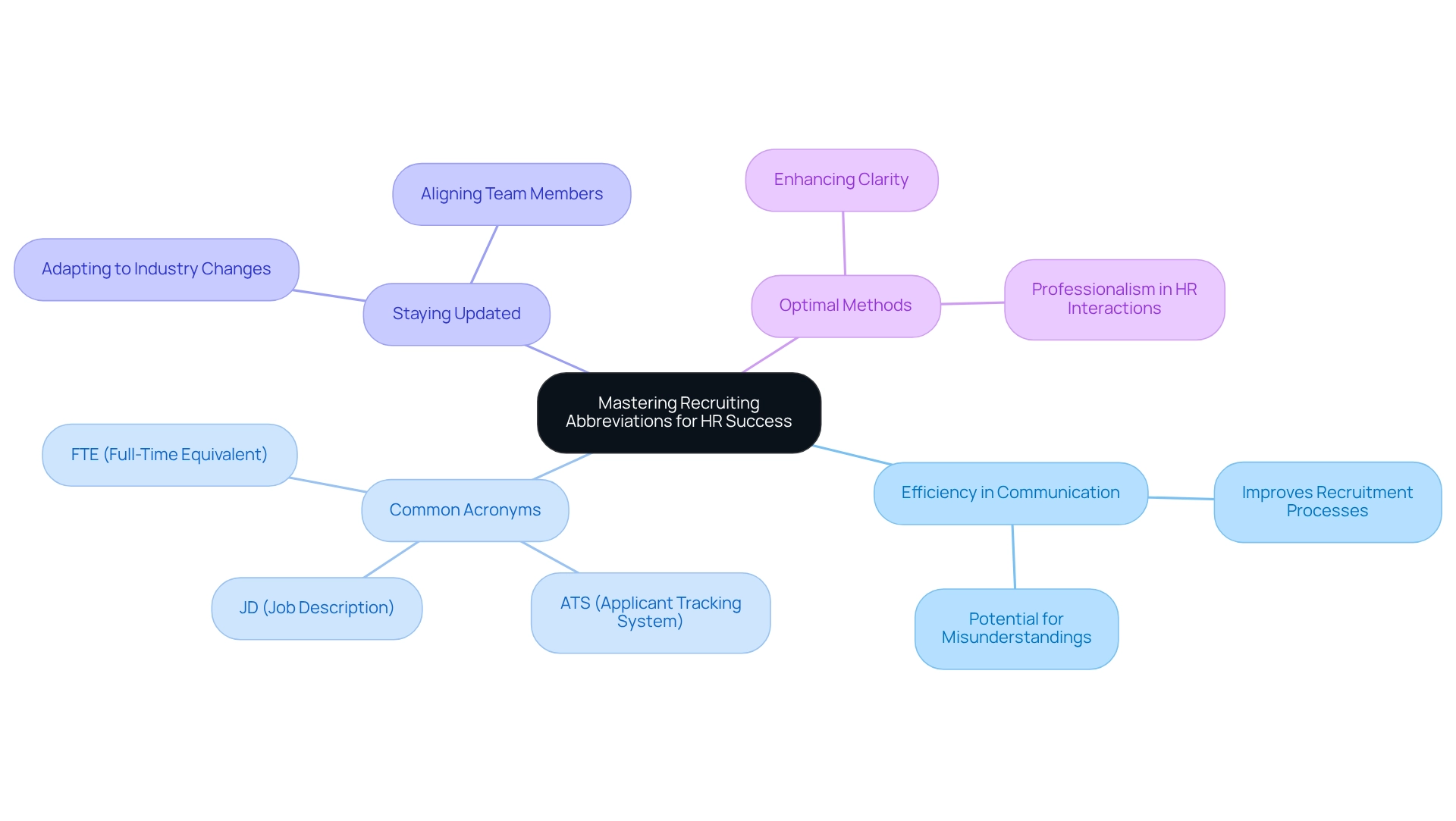
Conclusion
Understanding and effectively utilizing recruiting abbreviations is crucial for HR professionals in today’s fast-paced recruitment landscape. These shorthand terms, such as ‘JD’ for Job Description and ‘ATS’ for Applicant Tracking System, not only streamline communication but also enhance collaboration among teams, ultimately contributing to improved hiring outcomes. While these abbreviations can significantly boost efficiency, they also pose risks of misunderstandings if not used properly.
The importance of staying informed about evolving abbreviations is underscored, as new terms emerge in response to technological advancements and shifting industry practices. Implementing best practices—such as defining abbreviations upon first use and encouraging open communication—can mitigate confusion and foster a more cohesive recruitment environment. By adhering to these strategies, HR professionals can ensure that their communication remains clear and effective, which is essential for attracting and retaining top talent.
Ultimately, mastering recruiting abbreviations equips HR teams with the tools necessary to navigate the complexities of the hiring process. As communication continues to evolve, embracing these terms will not only enhance recruitment efficiency but also contribute to a more engaged and informed workforce. With the right approach, organizations can leverage the power of abbreviations to elevate their recruitment strategies and achieve greater success in securing the best candidates.
Frequently Asked Questions
What are recruiting abbreviations and why are they important?
Recruiting abbreviations are essential terms used in the hiring process to streamline communication and enhance efficiency. They allow HR professionals to convey intricate ideas concisely, which is crucial in the fast-paced hiring environment.
Can you provide examples of commonly used recruiting abbreviations?
Yes, some commonly used recruiting abbreviations include: ATS (Applicant Tracking System), JD (Job Description), FTE (Full-Time Equivalent), RPO (Recruitment Process Outsourcing), TA (Talent Acquisition), HM (Hiring Manager), RC (Recruiting Coordinator), KPI (Key Performance Indicator).
How do recruiting abbreviations impact hiring quality?
Recruiting abbreviations facilitate clearer discussions among HR teams, candidates, and hiring managers. For instance, a study showed that 62% of talent teams using an ATS reported sourcing higher-quality candidates compared to those who relied solely on inbound applications.
What is the significance of skills-based hiring in relation to recruiting abbreviations?
Skills-based hiring is gaining popularity, with 94% of employers believing it predicts job performance better. This approach necessitates clear communication, where abbreviations help express specific skills and qualifications swiftly.
What challenges are anticipated in the hiring landscape by 2025?
Anticipated challenges include hiring team turnover and increased competition for talent, which highlight the need for effective communication strategies in hiring.
How do expert opinions reinforce the relevance of recruiting abbreviations?
Experts emphasize that recruiting abbreviations enhance clarity and efficiency in hiring processes, allowing HR professionals to focus on strategic decision-making rather than lengthy explanations.
Why is it essential for HR professionals to understand recruiting abbreviations?
Understanding recruiting abbreviations is crucial for HR professionals to navigate the complexities of the hiring landscape effectively. It promotes clearer dialogue and enhances hiring effectiveness, leading to successful hiring outcomes.
